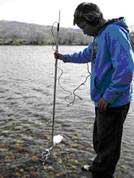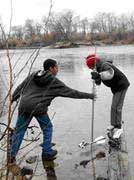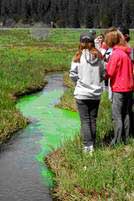Teaching K-12 fluid dynamics: the physics of flow
A FEd mini-grant report by Benjamin Blonder
 Can you teach the basics of fluid mechanics at the middle school level? At the McCall Outdoor Science School, we're beginning to do it. Our program is operated as a partnership between the Palouse-Clearwater Environmental Institute and the University of Idaho, focusing on delivering inquiry-based science programs to public schools across Idaho. Every year we serve approximately 4000 K-12 students with weeklong programs delivered in schools or at our campus in the mountains.
Can you teach the basics of fluid mechanics at the middle school level? At the McCall Outdoor Science School, we're beginning to do it. Our program is operated as a partnership between the Palouse-Clearwater Environmental Institute and the University of Idaho, focusing on delivering inquiry-based science programs to public schools across Idaho. Every year we serve approximately 4000 K-12 students with weeklong programs delivered in schools or at our campus in the mountains.
Recently we received a $500 mini-grant from the Forum on Education to help us implement a one-day program entitled 'the physics of flow'. We already have programs for river ecology, watersheds, and water quality monitoring, but rarely address the physical properties of water or the nature of flow. Nevertheless, these concepts are important and present in the state educational standards for middle and high school. Our new program can be delivered outdoors in the streams, rivers, and ditches near schools, using natural flows as our laboratory. We can cover concepts concerning fluids such as speed, inertia, viscosity, drag, mass transfer, and turbulence in a hands-on fashion. APS has helped us purchase a large quantity of fluorescein, a yellow-green fluorescent dye that is suitable for tracer experiments in natural bodies of water. Students use it in syringes to explore movement in a fluid for themselves.  APS has also helped us purchase a USGS Type AA current meter, an instrument that can directly measure speed in a stream. It has six conical cups mounted to a low-friction bearing that can be submerged to a desired depth; the rotations of the bearing are then transduced to a headset where they can be counted and timed by an operator. With an understanding of the rotation, the stream speed can be calculated. We use it to measure stream speed profiles and calculate total stream flow.
APS has also helped us purchase a USGS Type AA current meter, an instrument that can directly measure speed in a stream. It has six conical cups mounted to a low-friction bearing that can be submerged to a desired depth; the rotations of the bearing are then transduced to a headset where they can be counted and timed by an operator. With an understanding of the rotation, the stream speed can be calculated. We use it to measure stream speed profiles and calculate total stream flow.
Thanks to the quick grant review process, we've already received the equipment and implemented the program. I trained our teaching team on the proper use of our new materials in the middle of March; now at the beginning of May we've delivered the program six times to approximately 200 students, mostly in Title I schools. We've found that students respond very strongly to such exciting looking tools – not only does our program easily engage them, but they are also beginning to create an identity as a scientist. Fifth- and sixth-graders are able to understand our tools and begin to build their intuition for how fluids work. These initial successes mean we will continue to deliver this program this spring and fall – and will also use it with the 100 Upward Bound students hosted at our campus this summer.
 As a recent physics graduate and new educator, I'm very enthusiastic about integrating real science tools and physics into all of our outdoor science programs. Seeing this program come into existence with the help of APS has been a wonderful experience for me – my first ever grant!
As a recent physics graduate and new educator, I'm very enthusiastic about integrating real science tools and physics into all of our outdoor science programs. Seeing this program come into existence with the help of APS has been a wonderful experience for me – my first ever grant!
Benjamin Blonder received his BA in physics from Swarthmore College in 2008. He currently serves as an environmental educator in Idaho through AmeriCorps
FEd Mini-grants of up to $500 are available. Contact the FEd Chair, Peter Collings and the FEd Secretary-Treasurer, Bruce Mason for additional information. Turn-around on these proposals is rapid.
Disclaimer - The articles and opinion pieces found in this issue of the APS Forum on Education Newsletter are not peer refereed and represent solely the views of the authors and not necessarily the views of APS.
